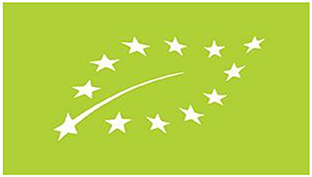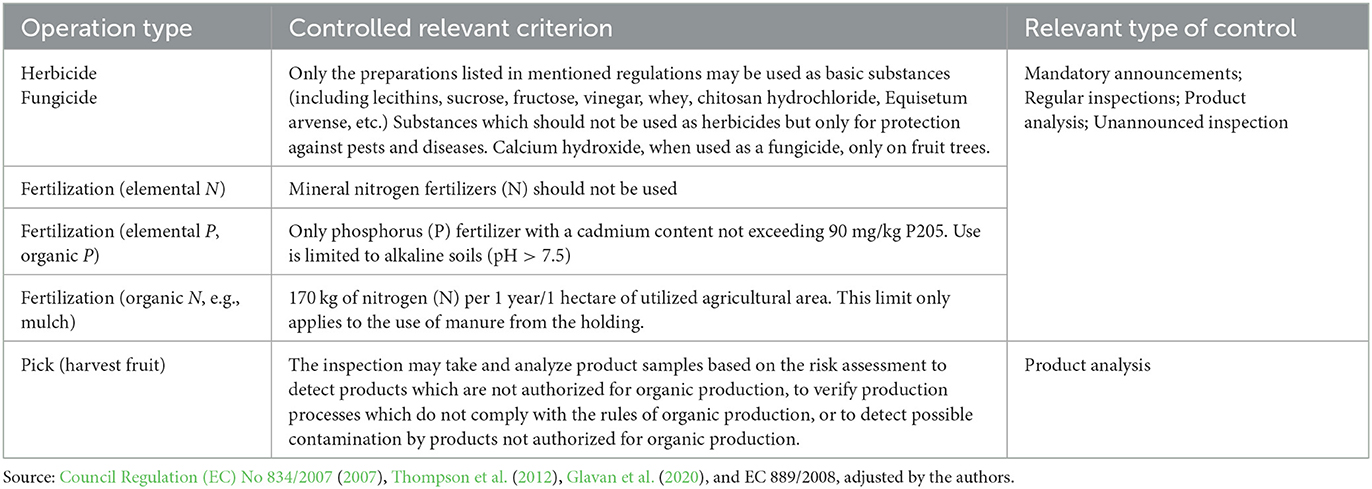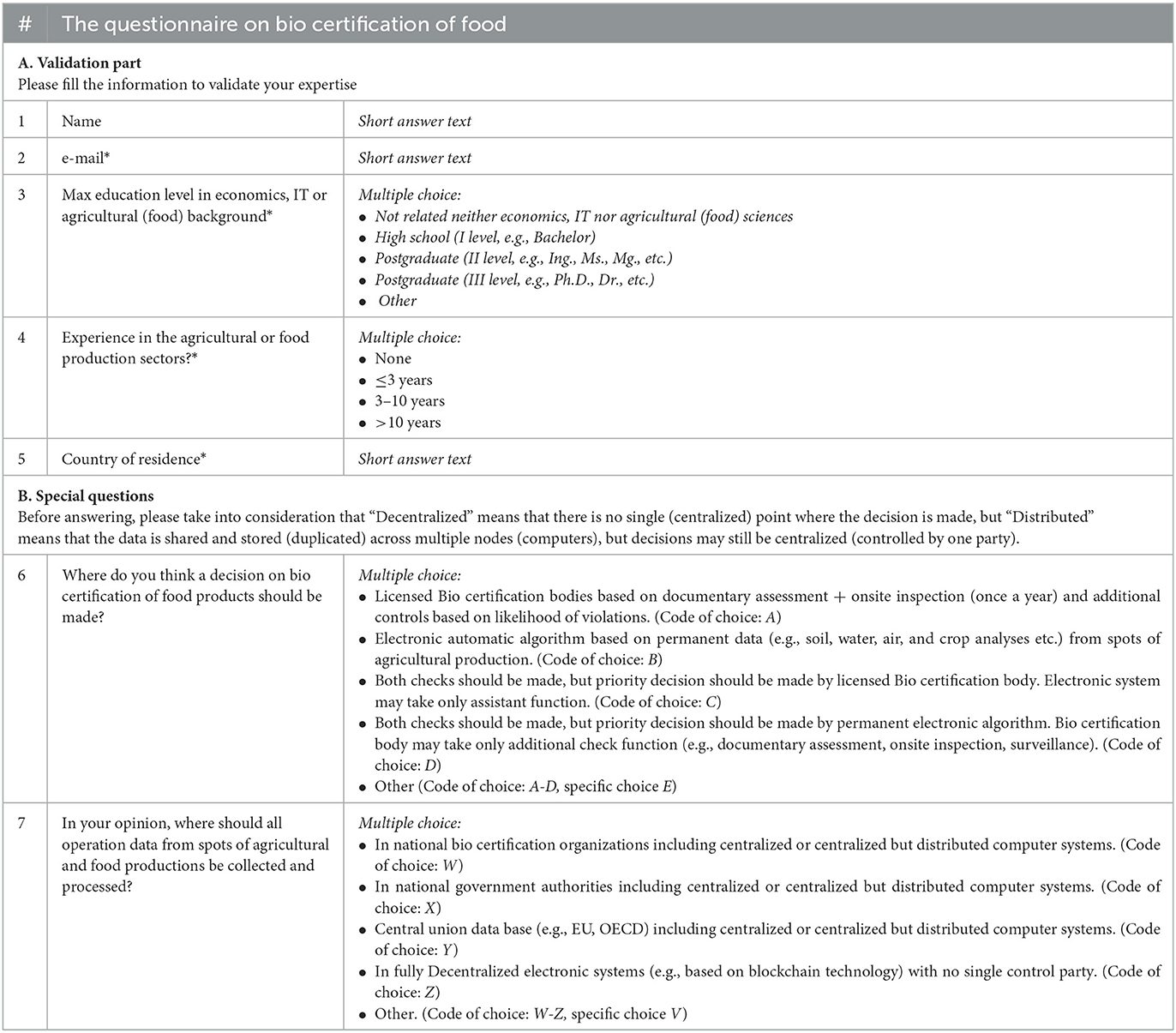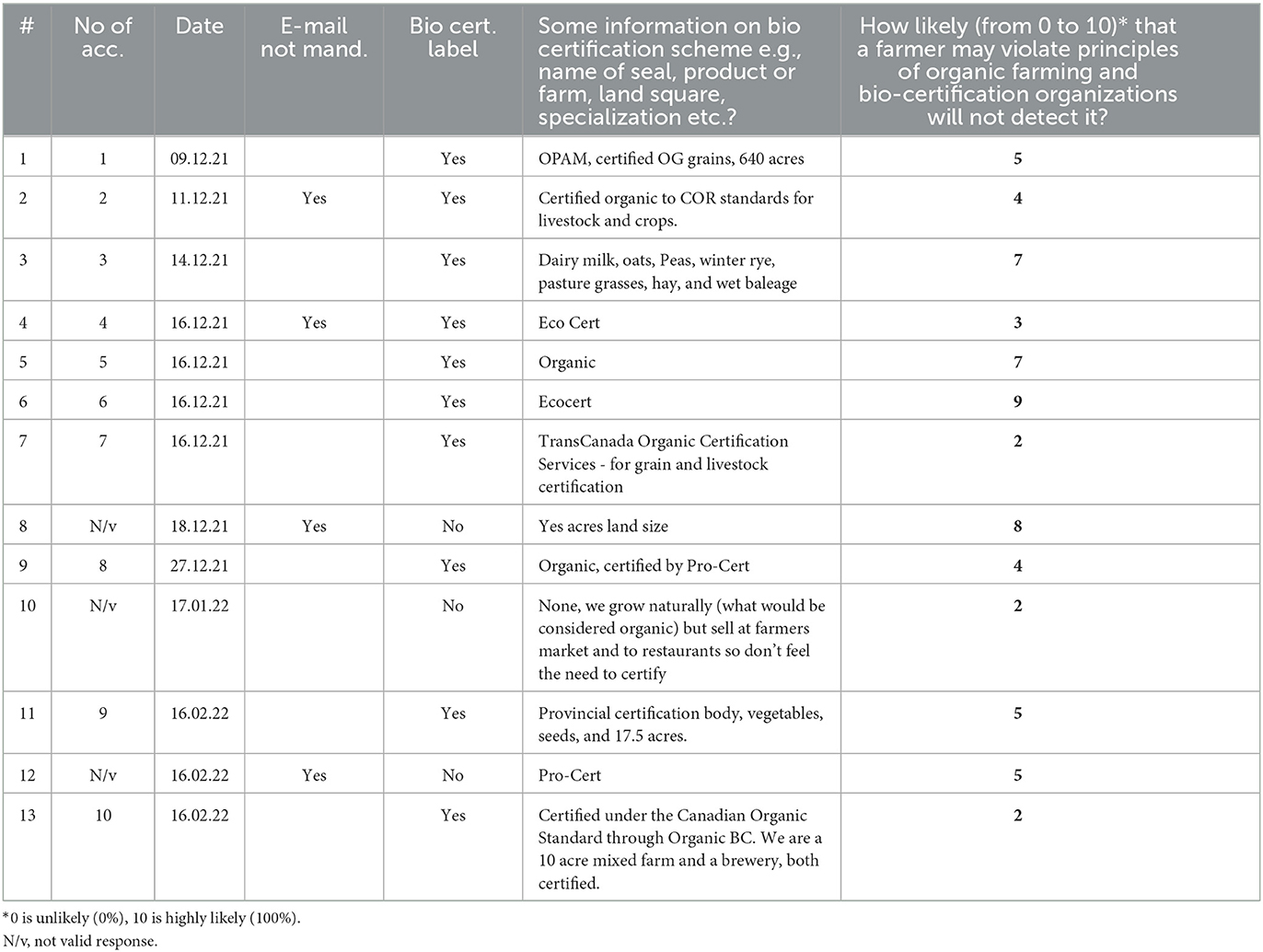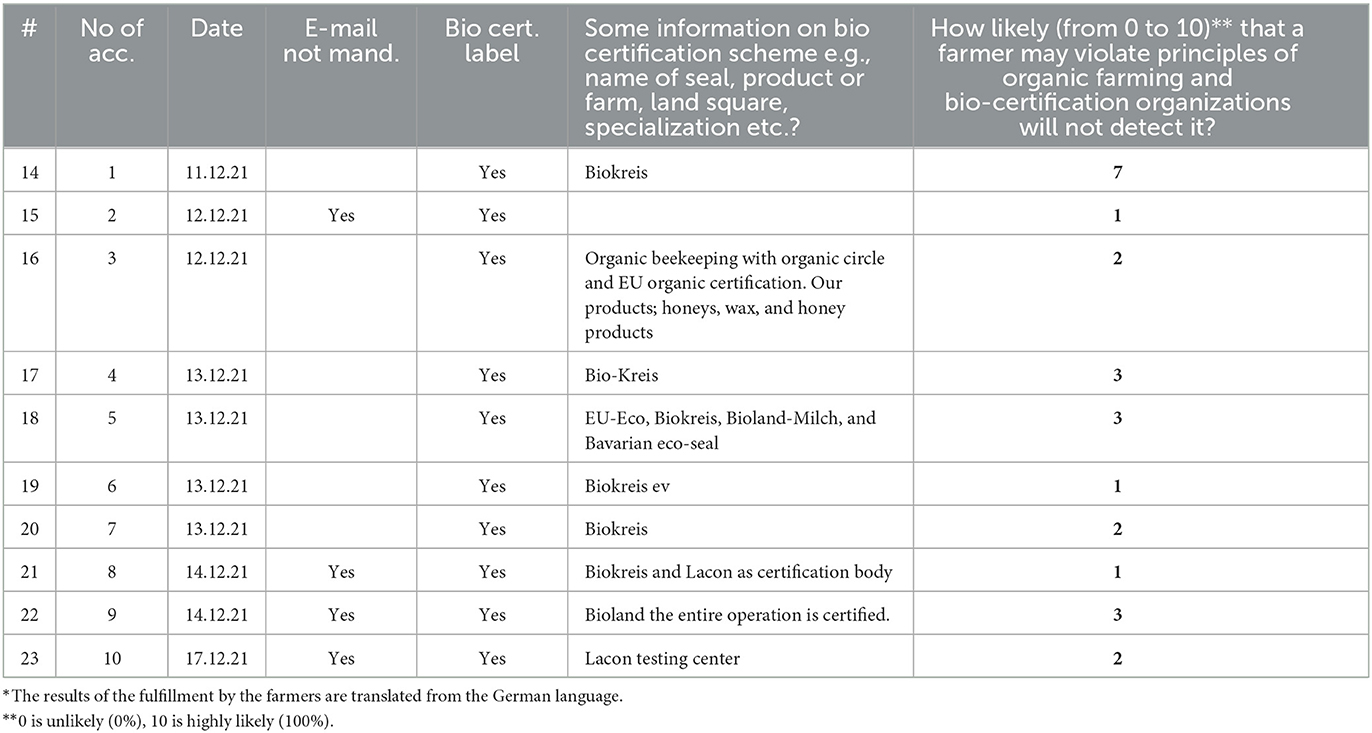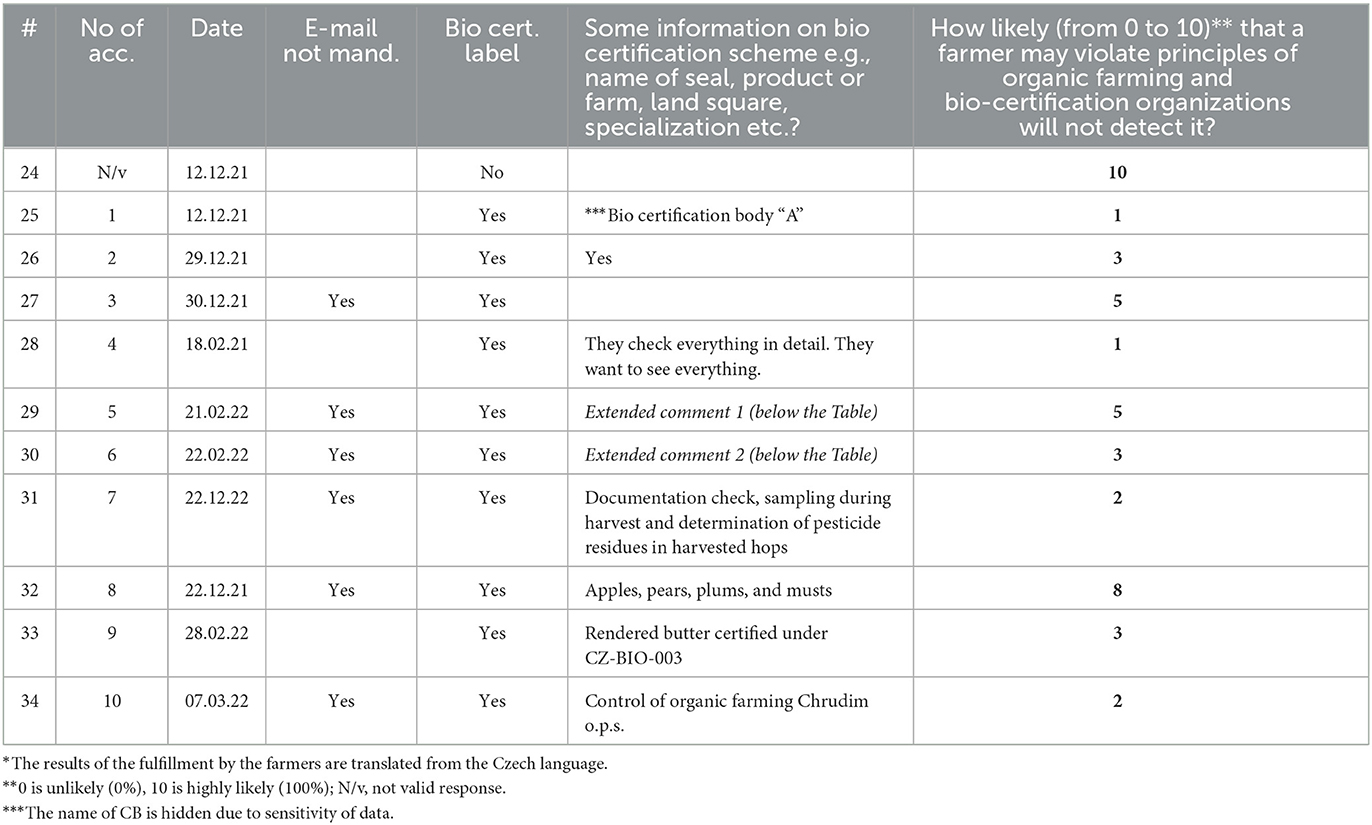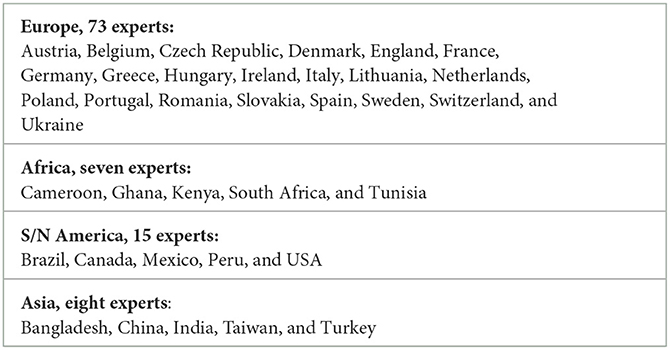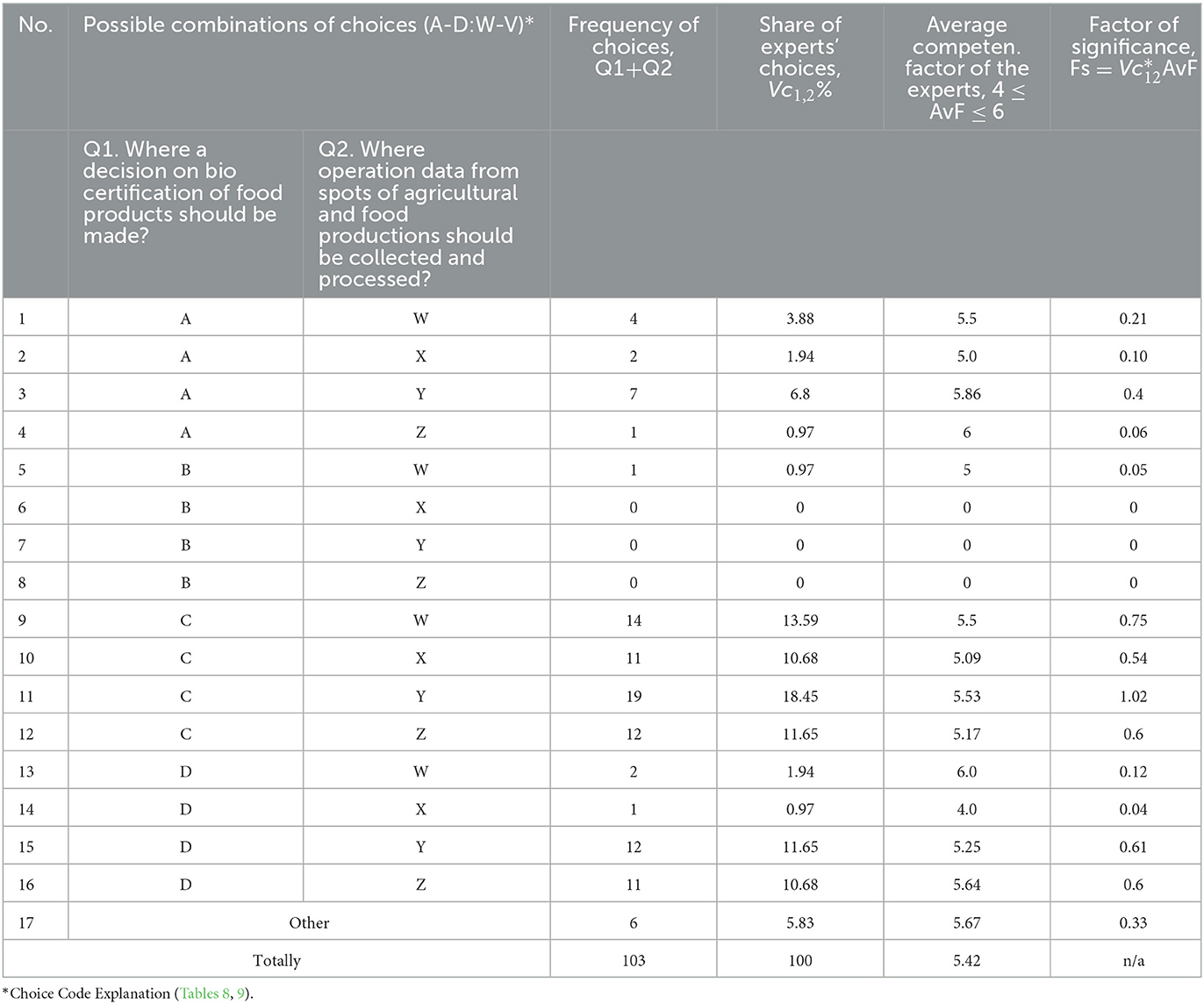- 1Department of Technology and Cybernetics, Faculty of Agriculture and Technology, University of South Bohemia in České Budějovice, České Budějovice, Czechia
- 2Department of Agroecosystems, Faculty of Agriculture and Technology, University of South Bohemia in České Budějovice, České Budějovice, Czechia
- 3Department of Food Biotechnology and Agricultural Product Quality, Faculty of Agriculture and Technology, University of South Bohemia in České Budějovice, České Budějovice, Czechia
The surge in the development of the organic food movement is in response to mass industrial food production, prioritizing productivity and economic profit across the global food supply chain, the cost of individual human health, the nutritional value of products, environmental degradation, and climate change. In recent decades, bio-certified food has become especially important to farmers, consumers, and policymakers as a viable transition away from high-input, intensive farming methods to a more humane and sustainable food system. However, to create value and a point of distinction in the marketplace, a robust and valid operation system to verify organic standards throughout the supply chain is of utmost importance. In this study, we conducted two separate surveys. The first survey targeted active organic farmers from three countries. Based on the data obtained, we confirm, similar to other investigations, that the current system of bio-certification is not reliable with a certain degree of probability. The second survey consulted highly specialized experts in organic systems from around the world to identify how the bio certification system should be transformed. The results indicated that the average probability of unregistered violations can be 35.4% according to self-reporting by organic farmers. This together with results that found that 96.12% of experts believe that the organic certification procedure needs to change provides increasing evidence and justification for an overhaul of the certification system.
1. Introduction
1.1. Development of the organic certification
Organic farming was first mentioned in 1924. Rudolf Joseph Lorenz Steiner (Staudenmaier, 2008), an Austrian social reformer, held the first courses on organic farming among 111 attendees in the city of Koberwitz, Poland (Paull, 2011). His writing “Spiritual Foundations for the Renewal of Agriculture” on biodynamic agriculture was published in the same year in Germany, which was probably the first reporting of organic farming as a complex system (Vogt, 2007; Von Friedeburg, 2018).
Organic food and farming systems are now defined by not using chemicals, in particular, synthetic pesticides and fertilizers, toxic herbicides, chemical additives, hormones, solvents, and genetically engineered materials (Allen and Albala, 2007). Therefore, until relatively recently agriculture was in essence organic, but the modern-day term organic has emerged in response to the mass industrialization of the food system, as such a large supply of food products are now non-organic (Drinkwater, 2009). In fact, modern organic standards prescribe that “bio” products must be 100% organic and strictly only up to 5% inorganic inclusions are admissible for processed products (Council Regulation (EC) No 834/2007, 2007; Safe Food for Canadians Regulations, 2022).
The earliest documents regulating the production and labeling of organic products at the EU level were published in 1991. In 2023, revised regulations of the European Commission 834/2007 and 889/2008, and a new EU organic regulation 2018/848 of 30 May 2018 were implemented. These policies describe the basic requirements for healthy food production and particularly the labeling of organic products in Europe. In the context of the legislation, healthy food is referred to in many terms, such as organic food, ecological food, biological food, and their derivatives and diminutives, such as “bio” or “eco,” alone or in combination (Regulation (EU) 2018/848, 2018). Such names are given to food and drinks which are produced in compliance with the standards of organic farming at all stages of production, preparation, and distribution. Organic products that are recognized by European standards are marked with an organic label which is often named “Euro-leaf” (Figure 1).
However, the rules of organic farming vary depending on the country of operation and the certification scheme itself. For example, in Germany, there were 17 bio-certification bodies in operation as of 2019 (Federal Ministry of Food Agriculture in Germany, 2020) and 46 organic entities in Spain as of 2022 (Organic Farming Information System Agricultural, 2022). However, all associated rules are united by common principles of ecological food production. These include the promotion of ecological balance, renewal and cycling of resources, conservation of biodiversity, restriction of chemical pesticides, toxic herbicides, synthetic fertilizers and additives, a ban on genetically modified organisms, ensuring crop rotation and companion planting, and enhancing soil fertility and water quality, among others (European Court of Auditors, 2018; Regulation (EU) 2018/848, 2018). Organic certification regulation in non-EU countries where a regulation has been developed does not fundamentally differ. For instance, in Canada, an organic product is an agricultural or aquacultural product that has been certified organic under Part 13 of the Safe Food for Canadians Regulations (SFCR; SOR/2018-108). To obtain the certification, operators must have their products certified by the Canadian Food Inspection Agency (CFIA), the accredited certification body, and develop an organic production system based on the Canadian Organic Standards CAN/CGSB 32.310 (311,312). The European Union (EU) and Canada recognize that their respective organic production rules and control systems are equal to each other (Canada.ca, 2016, 2023). This equivalency agreement means that certified organic products meeting Canadian or European organic standards may be sold and labeled as organic products in both the EU and Canada.
The Directorate-General for Agriculture and Rural Development (DG AGRI) deals with managing and developing the EU organic platform of the Common Agricultural Policy. The Directorate-General for Health and Food Safety (DG SANTE) covers the enforcement of EU legislation on food safety, animal health, animal welfare, and plant health, providing validity to organic production by evaluating compliance with EU standards. In turn, Member States are responsible for monitoring and controlling compliance with EU standards and establishing the type of control system (private, public, or both) as well as the number of control entities (European Court of Auditors, 2018). The International Federation of Organic Agriculture Movements (IFOAM) is an umbrella organization that promotes the organic movement worldwide and offers organic accreditation to certification bodies (ifoam.bio). Finally, the European Organic Certifier Council (EOCC) is the head certification association that represents local organic control bodies within Europe, aiming “to increase the reliability of control and certification activities and decisions in relation to European organic agriculture” (eocc.nu).
The entire system of organic certification is based on the control of compliance with the criteria for organic production. This applies both to the initial receipt of an organic certificate and to the subsequent renewal of its validity every year. These tasks are performed by the certification bodies. A control or certification body (CB) is an independent third party or public administrative entity of a Member State that has been accredited for a sector and carries out local certification services. Within organic production, this includes making decisions for organic certification by satisfying at least a minimum set of formal requirements by conducting onsite inspections and sampling tests and establishing administrative methods of control. Where an operator is compliant, the CB issues a certificate that assures the adherence to the underlying organic standards and empowers the operator to put the Euro logo on their products (Gantz, 2014; Zezza et al., 2020).
1.2. The basic types of CB's control in the EU
The following types of control market operators are the main methods of certification bodies and are based on the key regulation documents: EC 2092/91; EC 178/2002; EC 2003/2003; EC 834/2007, EC 889/2008; 1235/2008; and EC 1107/2009. They are also summarized in the latest EU 2018/848.
1.2.1. Mandatory announcements from operators
This type of control occurs as part of the provision of mandatory required information. In particular, the bio-certified operator should immediately inform regulators about any irregularity or infringement concerning the organic status of its product/farm or organic products obtained from other economic operators or subcontractors. Moreover, bio-organic operators should record all data concerning production. Such records must provide at least the following information: (a) use of fertilizers: date of application, type and quantity of fertilizer, and land utilized; (b) use of plant protection products: reason and date of treatment, type of product, and method of treatment; (c) purchase of inputs to the farm: the date, type, and quantity of products purchased; and (d) harvest date and the type and quantity of organic or conversion crop.
1.2.2. Regular inspection
Physical inspection for each contracting operator is done at least once a year. In the case of agricultural producers who produce crops, it must be carried out during the growing season or until harvesting certified crops. A responsible representative of an operator must be present at the agreed date of the inspection, which will provide the inspector with binding information and allow access to the relevant documents. The inspection visit covers all processes that are associated with the production of organic products. In particular, (a) inspection of production facilities (storage facilities), inspection of premises and packaging facilities and control of stored products; (b) control of production processes including separate bio-production flows; (c) control of input and output documentations and products; (d) verification of supplier certificates; (e) control of the flow of goods; and (f) final interview.
1.2.3. Product taken for analysis
At a minimum, 5% of operators must have soil samples for analysis. The selection of operators to be sampled is based on a general assessment of the risk of non-compliance with organic production rules according to International Sustainability and Carbon Certification (ISCC) risk categories (ISCC, 2021). This overall assessment takes into account all stages of production, preparation, and distribution. The public or private inspection bodies take and analyze samples whenever there is a suspicion that products or processes that are not authorized for organic production are being used. This is conducted through a primarily unannounced inspector based on a general risk assessment of non-compliance to organic production rules.
1.2.4. Unannounced inspection
A minimum of 10% of contracting operators a year will undergo an unannounced inspection. CBs perform irregular and unannounced inspections, based on risk assessment, where operators with higher levels of risk should be included in the plan of unannounced inspection.
Table 1 lists the recognized types and subjects of control for a common European producer of organic grapes.
The other operation types, such as pruning (cut of shoots), general maintenance, wire adjustment, disbudding (removal of shoots), canopy management, shoot thinning, crop measurement, netting, and bunch counts, were not clearly identified in relation to any controlled criteria by relative baseline legislation and thus they are not covered under control measures.
1.3. Criticisms regarding bio-certification practices
There are a few studies in the literature that investigate the consistency of third-party certification. According to the investigation of Fouilleux and Loconto (2017), some variations in how CBs operate can lead to consumers' disappointment and even fraud. The reasons for the discrepancies in the evaluations of CBs may significantly depend on how CBs interpret the standards and non-quantifiable recommended practices (Fouilleux and Loconto, 2017). Bar and Zheng (2019) found that food operators are inclined to collaborate with those CBs who are the most loyal. The bio-certification model assumes that the financial success of CBs is also equally dependent on the loyalty of the operators themselves, as it directly depends on their fees and payments. Furthermore, Kononets and Treiblmaier (2020) found that in practical terms some large German retails do not trust most bio-certification schemes and, therefore, have instigated their own procedure for investigating the “purity” of producers and their products, including analysis of production facilities and physicochemical analysis of products, before issuing a contract with producers.
Furthermore, recent investigations in Italy found that there is a direct dependency between the audit outcome and the CB performing the audit, and the probability to fall under sanctions of a CB directly depends on the share of unannounced spot inspections of a particular CB (Zezza et al., 2020). Earlier, Gambelli et al. (2014) studied a likelihood of detected violations in different adoption measures one of the local CB. In German food quality control industry were found the same regularities (Zorn et al., 2012; Bravo et al., 2013). However, based on the European Court of Auditors (2019), the control system for organic products has improved, but some challenges still remain. For example, in the Czech Republic, several cases have been found where the Certificate of Inspection stated results of laboratory analyses were not actually produced and vice versa. According to the European Court of Auditors (2019), there are two control bodies in Italy, which carry out most inspection visits each year; however, these inspections are uneven throughout the year and excessively inefficient in terms of plant production. Based on another report on the overall operation of official controls performed in Member States (2019–2020), it was found that EU programs were effective in meeting the targets on the prevalence of Salmonella bacteria. However, the rate of detection of Salmonella levels in samples taken by private third parties of control was on average essentially lower than that of the official tests by state authorities (EC Report, 2022). Therefore, considering that private third parties cover much more territories, this discredits the organic industry as a whole.
Based on key indicators globally and particularly in the EU zone during 2000–2020, organic agriculture has been growing rapidly for the last 20 years (Table 2). This presents increasing operational burden and bureaucracy on control entities, such as increased data volumes, which can exacerbate the current issues and criticisms of private CBs (Table 2).
1.4. Review of possible improvements of the organic certification procedure
To improve organic control mechanisms, a number of suggestions have emerged from the research literature. For example, a mechanism of enhanced supervision and prevention of both intentional and unintentional types of fraud (Padel et al., 2010). More recently, it has been proposed to reinforce the risk-based approach to controls and surveillance activity, particularly, to balance controls with vigilant risk analysis and standardization of procedures at both national and EU levels. The rotations of CBs and inspectors and further standardization of fees and procedures in combination with regular third-party audits, are some further focused measures recommended to improve the certification model for the organic market (Zezza et al., 2020).
The European Court of Auditors (2019) published recommendations for improving the control system for organic products in the EU, recommending to the EC to: (a) address remaining weaknesses in Member State control systems and reporting; (b) improve supervision over imports through better cooperation; and (c) carry out more complete traceability checks. In particular, the EC stated that too many products still cannot be adequately traced back to provenance. Furthermore, a recent EC report concluded that there was a need to improve the transparency and traceability of animal-origin proteins across the food supply chain (EC Report, 2022).
1.5. Research objectives
Previous research suggests the current system of bio certification is not 100% reliable, which makes it possible for violations and deviations from the principles of organic farming to occur. Therefore, collecting supporting evidence on the degree of such deviations in practice is the first objective of this investigation. The reliability of the bio-certification system cannot be, in some cases, supported by the faith and hope of final consumers that bioproducts are produced under conditions that fully meet the principles of bioproduction. Thus, the outcome of the first purpose of the study could be expressed by confirming or rejecting the following hypothesis.
Hypothesis: Accepted organic certification schemes do not guarantee 100% compliance with the principles and rules of organic production, regardless of where organic production is located.
The hypothesis can be considered confirmed only if 100% of randomly surveyed farmers in different countries with a valid bio certificate confirm a positive probability (>0%) of a violation of the principles of organic production without subsequent identification by the inspection body. Otherwise, the hypothesis is rejected.
The second objective of this study is to investigate the optimal structure for collecting, storing, and distributing data from organic farm sites and the level of decision making for organic certification. These two factors depend directly on the degree of transparency of the entire bio-certification system. Of particular value is the combination of these two aspects into a single relationship. Thus, the final outcome of the second objective of the study will be the discussion of a possible new model with promising bio-certification procedures based on the obtained data. Any alternative organic certification system will need to provide a 100% guarantee of the organic origin of products. The current study also intends to investigate the emerging approaches in the evolutionary development of the bio-certification model and, in particular, try to determine the possible extent of the use of digital technologies into decision making in bio certification, which could have a possible effect on the degree of current objectivity in the given process and avoid the issues associated with human error. For example, Kononets and Treiblmaier (2020) stated a very high likelihood of 55% that digital contracts in the food supply chain will eliminate the impacts of human mistakes and intentional unfair practices.
2. Materials and methods
2.1. Anonymous survey of bio farmers
The goal of an anonymous survey of bio farmers was to determine the approximate level of self-reported violations by the producer of food products that for some reasons were not identified by a certification body. Since this kind of information is not currently available, an anonymous survey of farmers working under any bio certification label was utilized. Conducting scientific observations or practical tests in the field to determine the required data was not possible. Anonymous surveys were conducted only in certain countries of the EU based on the historical, geographical, and statistical data. Germany has the most developed culture of bio production with the oldest history and experience and the largest number of public and private bio certification organizations that authorize and certify bio productions (Organic Farming Information System Agricultural, 2022). The Czech Republic was also chosen as one of the largest shares (11.24%) of farmers managing only organic or partially organic land, with an overall European average of 2.37% in 2016 (Eurostat, 2016). In addition, the Czech Republic ranks fifth in Europe in the percentage (15.33%) of total organic area (fully converted and under conversion to organic farming) while Germany (9.59%) is the closest to the European average of 9.08% among the EU-28 countries (Eurostat, 2020). Of additional scientific interest in these particular countries is the data that show that Germany has the highest percentage increase of 65.75% in the total organic area (fully convertible and under conversion) between 2012 and 2020. At the same time, the Czech Republic, one of the leaders in the percentage of organic farmers and organic land, showed the worst growth rate of equivalent area, only 15.3% over the same period (Eurostat, 2020). Although it is worth noting that the Czech Republic and Germany do not represent all the countries of the EU, however, they can be seen as the most representative not only in terms of statistical data and one of the most ancient traditions of eco-farming but also in terms of their location in the temperate transitional climate within Europe.
To test our hypothesis that violations of the rules and principles of organic certification are likely in any developed country, including a non-European country, we intended to find an agrarian country with different but also developed organic certification standards. Canada met this criterion well. Canada has one of the largest organic area share of total farmland among the countries of North and South Americas at 2.44% (Research Institute of Organic Agriculture, 2021).
Therefore, territories of these three countries (Germany, the Czech Republic, and Canada) were chosen for the survey where organic farmers operate. However, it is important to emphasize that this research does not aim to study the levels of possible violations with the highest degree of accuracy. This cannot be verified using anonymous questionnaires. The investigation, however, seeks confirmation in the form of personal testimonies of real bio farmers. This evidence aims to deny or reinforce existing assumptions about possible violations and adds to the body of evidence of older and more recent findings of other investigations: Zorn et al. (2013), Bar and Zheng (2019), European Court of Auditors (2019), Karalliyadda and Kazunari (2020), Zezza et al. (2020), Miśniakiewicz et al. (2021), and Nowicki et al. (2021). Finding effective ways to prevent and significantly reduce the likelihood of possible violations by some organic farmers is the motivation for the second objective of this study.
The questionnaire contained non-personalized but one key specific question: “How likely (from 0 to 10) do you think it is that a farmer may violate any rules or principles of organic farming and bio-certification organizations will not detect it? *0 is unlikely (0%), 10 is highly likely (100%).” This question is not only aimed at measuring the reliability of the organic certification system but also at understanding the perception of organic farmers toward the reliability of CBs and the behavior of other organic farmers. Organic farmers are the key stakeholders and primary target audience and their perception of how likely it is that they themselves are in breach of the rules of organic farming is an important indicator of the rigor of the certification system. As the regulatory criteria between the EU countries and Canada are generally replaceable and mutually recognized in the legal field (Canada.ca, 2016, 2023), the results of the first survey among the given countries can also be considered valid for comparison.
Due to the high sensitivity of this question, providing an email address was not mandatory because respondents may not wish to disclose their identity. Email addresses and additional information were requested from the respondents as an additional measure of validation in case there were any concerns about the eligibility, authenticity, or competence of a farmer to complete the questionnaire. It is also possible that not all organic farmers use email or social media and respond to electronic requests; however, this factor should not and cannot affect the response itself. The question was deliberately depersonalized to enable farmers to answer truthfully. However, farmers' individual preferences regarding the disclosure of their opinion on this subject and their personal propensity to violate is expected to influence their answer.
Different tools were used for achieving the target audience. In particular, in the Czech Republic, bio certified farmers were contacted via email to a total of ~1,300 bio food producers [available at the web portal of the Ministry of Agriculture of the Czech Republic (eAGRI)]. In Canada, a dual approach was used: (1) a direct email to around 160 bio farmers [contacts taken from the Organic Federation Canada (OFC) and the Organic Council of Ontario (OCO)] and (2) open public posts in Facebook groups that are dedicated to organic farming in Canada with an overall membership of 0.5 million. In Germany, around 200 bio farmers were contacted via email (from the Ecocert Group portal).
The questionnaire was delivered to participants in their local language (respectively for the Czech Republic in Czech, for Germany in German, and for Canada in English). Validation of farmers' responses was based on two criteria about the country of residence from the list of targeted countries and a positive answer to the question about the presence of any bio certificate relating to their farming activity. For each country, the average of the responses was calculated and the obtained result is presented as the estimated average for that country as:
Where LAv is the average likelihood of received responses for a country in %, L is the assessment of the likelihood of violating the organic principles by a farmer, and Q is the quantity of all the obtained and approved responses for a country.
2.2. The survey among international experts
The purpose of the second survey was to identify opportunities for further improvement of the model for bio-certification of food and agricultural production. Building on the results of the survey conducted with farmers, the authors identified two key questions for the analysis of the bio certification system:
• Where should the optimal body or decision point for bio certification of products be?
• Where should constant and variable data on food products be collected and processed?
This information was obtained by a survey with experts with the appropriate level of qualification and experience in the organic and certification sectors. The survey was conducted using an online questionnaire which was open between December 28, 2021 and June 7, 2022 (5 months and 11 days). Electronic requests were sent out to potential target experts, who were recognized researchers in the relevant field. The data to identify an electronic mailing list was taken from available information sources, mainly, scientific databases such as Scopus, Research Gate, and Web of Science. Most of the experts were identified by relevant scientific documents with key words such as “Certification of Food” and “Bio certification.” In total, 5,848 emails were sent to invite research experts to fill in the questionnaire. Experts were identified and invited mainly from Europe, although there was no geographical limit. Moreover, the geographical affiliation of an expert was not considered in the analysis of the observed questions, but it was collected for general statistical information.
The involved experts were deemed to not have a conflict of interest. As far as the authors are aware, the experts are neither directly nor indirectly connected to the existing certification system. However, they have theoretical knowledge of the subject and may have relevant practical experience. Furthermore, they generally do not belong to any particular territory, which means that their answers are generally not influenced by any particular legislation, ethnic composition, religion, geographical location, etc. and can therefore theoretically be considered as objective as possible. Consideration of other international and local standards will not affect the results and conclusions of the study as it is considered as an ideal scheme in the view of admitted experts.
The following scoring system was created by the authors to validate each expert and the acceptance of their choice for further analysis. This was designed to enhance the overall quality of the responses and to maximize the validity of the data and the general credibility of the survey data. An expert was approved for the survey if the sum of their points for education and practical experience in the agricultural (food) industry equals at least 4 (total points ≥ 4). Thus, for the level of education in the relevant areas (Economics, Biology, IT, or Agriculture/Food) and practical experience in agriculture or food industries, the following points are assigned (Tables 3, 4).
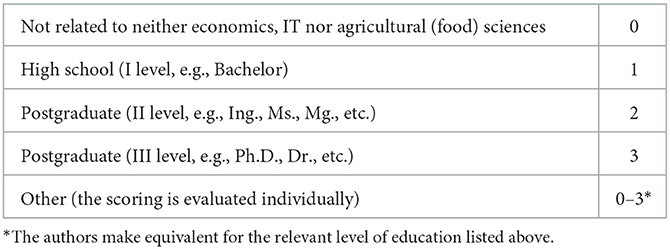
Table 3. Points for maximum education level in economics, biology, IT, or agricultural (food) background.
The total points for education and experience cannot fall below the four-point threshold for an approved expert to consider their opinion. The validation system was designed to obtain as high competence as possible both in theory and practice (Table 4).
If a respondent scores 0 for one of the two criteria or their total score is <4, the expert was not validated for this survey. Their answer was recorded but was not included in the results of the study.
In total, the questionnaire (Table 5) for the survey of international experts had a total of seven questions, of which five are dedicated to validation and the remaining two are target questions.
Each choice option was assigned a specific text symbol to facilitate the explanation of the meaning of each choice. Therefore, a different “Code of choice” was assigned to each option. For the first question (Q1), there are codes with possible values from A to E, and for the second question (Q2), there are codes with values from V to Z relatively. The specific choice E is presented for question Q1, and V for question Q2, respectively. However, respondents can answer “Other,” where a respondent indicates a conceptually different answer from all the listed answers.
2.3. Data analysis
2.3.1. The majority of choice by each question
The definition of an absolute majority on each of the key questions (Q1 and Q2) is the most predictable option among the involved experts in a given number. The share of votes for each issue is determined as follows:
where VCX is a share of experts' votes for a definite choice option in %, QCx is the total quantity of responses on a definite choice, and q is the quantity of all validated responses.
2.3.2. The majority and the significance of the combination of choices for both special questions
This analysis implies ranking by the most frequent combination of answers to the main questions Q1 plus Q2. This means that not just the absolute largest number of possible choices per question was determined, but actually two absolute answers are taken into account within one questionnaire. It was worth considering that the absolute majority of answers to questions 1 and 2 together do not necessarily have to coincide with each of the absolute largest answer options for each of the main questions separately. Thus,
where N1, 2…16 is the number of choices for each out of the 16 possible basic combinations of Q1 and Q2.
To consider the degree of competence of each expert and to derive the average competence of experts who chose a certain combination of answers, it was necessary to determine the average competency factor (AvF) of experts for profile experience and education for each possible choice of answers. Thus,
where Q is the number of respondents that chose definite combinations and Tp is the total points of each validated expert (4 ≤ Tp ≤ 6).
To determine the significance of a choice (Fs), taking into account the average competence of respondents in a particular choice and the share of such a choice among all respondents, we find:
The current system of bio certification was represented by choice A (Licensed Bio certification bodies based on documentary assessment + onsite inspection once a year and additional controls based on the likelihood of violations) in question Q1 regarding the most preferred level for making decisions on bio certification, and choice W (in national bio certification organizations including centralized or centralized but distributed computer systems) in question Q2 dedicated to determining the most preferred level for managing data processing in the bio certification mechanism. Thus, it is possible to conduct a comparative analysis of the possible prospects of a widely functioning scheme with possible other options.
3. Results
3.1. Determining the likelihood of violating the rules and principles of organic farming without subsequent detection of the certification body
The survey of existing farmers working under any bio certification license was conducted between 9 December 2021 and 7 March 2022 and lasted for almost three calendar months. This survey aimed to understand the likelihood of violating the rules and principles of organic farming among bio farmers in the Czech Republic, Germany, and Canada. The survey was completed with 34 accepted and 30 approved responses, constituting 10 completed and approved questionnaires from each target country.
The coverage on social media outlets amounted to about 1 million users in the three countries in total; however, the actual success rate of completed forms via social media was 0.0015% or 15 questionnaires. This is likely due to the high sensitivity of the survey topic and the questions themselves, which can be seen to discredit farmers and the organic brand and certification process, which they work under. Sending direct targeted invitations to farmers' via email addresses proved to be more effective, where the “ignore” rate reduced from almost 99.99–98.7%.
Quantitative characteristics of answers can be the subject of reasonable criticism from experts, but there are some weighty reasons to consider them in our investigation. The authors had the task of identifying and directing inquiries to only organic farms. The percentage of organic farms in the total holdings in each country is much lower and is on average 2.37% with only organic or some organic areas across the EU-27 (Eurostat, 2016). According to recent research (Kononets and Treiblmaier, 2020; Kononets et al., 2022), the percentage of farmers in some European countries who use email on a daily basis is around 20%, which is quite low. Considering the nature and sensitivity of the first survey, it was quite valuable to obtain at least one testimony. A total of 10 such testimonies from each country form the basis for the scientific discussion. Finally, data from 30 responses were used to test our hypothesis and confirm the positive probability of violations.
In total, four completed questionnaires (11.76%) did not pass the verification process and, therefore, were not included in the results. Of them, three were not approved as they work without any bio-certificate and one respondent was from a non-target country, respectively.
Finally, Tables 6.1–6.3 show the responses of each approved organic farmer.
In addition, two bio-farmers from the Czech Republic left detailed comments (translated from Czech) on the issue:
Extended comment 1: “I can imagine that there may be ‘organic farmers' who grow crops in the fields and fertilize with industrial fertilizers—I see large industrial farms as the most risky here, which will switch to organic for purely financial (greedy) reasons and are not really about this style of farming conviction” (Respondent #29).
Extended comment 2: “However, it is clear to me that not everything organic is really ‘organic'” (Respondent #30).
Figure 2 shows the aggregated data from survey 1. As a result, German farmers believe that the probability of an unrecorded violation can be on average, 25.0%. In the Czech Republic, this figure is higher, at 33.0%. Canadian farmers think that this probability can be much higher, equating to 48.0%. Accordingly, the average across the three participating countries is 35.4%.
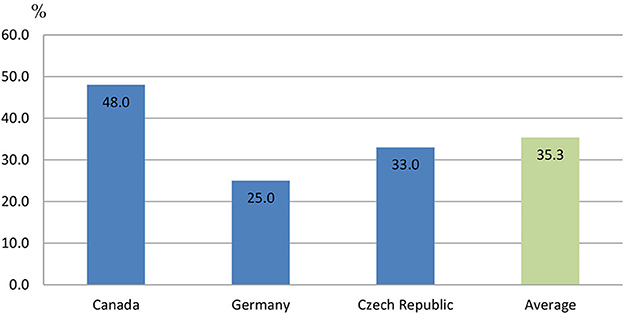
Figure 2. The average likelihood of bio certification reliability in countries. The average likelihood in (%), by opinion of bio farmers in given countries, that a farmer may violate any rules or principles of organic farming and bio-certification organizations will not detect it.
Hence, we obtained a complete confirmation of the hypothesis within the first objective of the study. This is because all 30 respondents (100% of farmers from three countries) positively estimated the probability (>0%) of a violation by a farmer without further consequences (overall, an average likelihood of 35.3% was obtained).
3.2. Identification of opportunities for the possible evolution of bio-certification procedures for food and agricultural products
3.2.1. Approved experts
The survey with international experts was conducted between 28 December 2021 and 26 June 2022. In total, 130 respondents filled out the questionnaire, of whom 27 (20.76%) did not pass the validation process; therefore, their data were removed from the results. In particular, 17 experts were not approved due to absence of experience in the agricultural field, three respondents do not have appropriate education, six respondents have both insufficient experience and lack of education in relevant fields, and one expert did not identify himself neither by name nor email address and therefore his answers were deemed not reputable and reproducible. The respondents provided the required information and their email addresses for checking the results. In total, the results from 103 experts were accepted. Of them, 91 or 88.3% of respondents had the third level of postgraduate education (e.g., Ph.D. and Dr.) in a relevant area of science, while the remaining respondents (11.7%) had a second level of appropriate education in agricultural, biological, food, economics, or IT sciences (e.g., Ing., Ms., and Mg.). Concerning practical experience, 64 experts or 62.1% of respondents had more than 10 years of practical experience, 31 experts or 30.1% of respondents had between 3 and 10 years of work in the food and agricultural sector, and only eight respondents (7.8%) had <3 years of practical experience.
The geographical spread of experts was found to be quite large. Experts were engaged in research from the continents of Europe, America, Asia, and Africa. More details are provided in Table 7.
Table 7 shows that the participating experts were from 36 countries and four continents. For the purposes of this survey, this factor does not have a significant impact on the overall result of the survey. International experts were involved who are deeply focused both on organic certification and digitalization issues. In our case, there were as many as 130 such expert opinions. Of these, 103 approved responses were included in the final results of this investigation. From this point of view, the number of experts working in this field of science is quite sufficient for the purposes of this study.
3.2.2. Opinion of experts for improving the process of bio certification
The first research question was aimed at determining the degree of priority for electronic systems based on objective data in the process of making a decision on bio certification. The survey results showed (Table 8) that 59 of 103 (57.3%) agreed that a licensed body should play a key role in the decision to certify products, while electronic systems should play only a secondary or assisting function in the process. In turn, 26 experts (25.2 %) believed that the decision of bio certification should be made mainly by electronic algorithms, and bio certification organizations should only play a supporting role. At the same time, 14 respondents (13.6%) believed that the decision should still be made only by the bio certification company, with only one expert indicating that the decision of certification would be better made by an electronic automatic algorithm based on entering data on soil, water, air, and product analyses. It is also worth noting that three experts marked the answer option “Other.” The first of them (respondent #58) wrote:
“Data should be fused along the chain and shared among actors as well as with certification bodies. Only parties in the chain can ensure authenticity of the organic products eventually.”
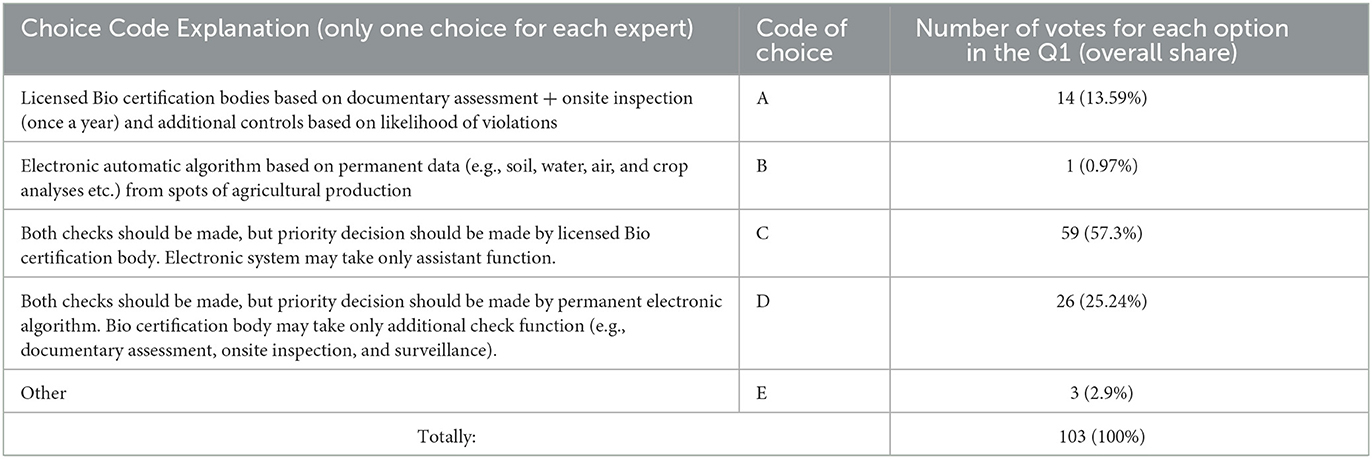
Table 8. Opinion of the experts among predetermined options A–D on where a decision on bio certification of food products should be made (Target question 1, Survey 2).
Although this commentary is interesting, it reflects the property or technical characteristic of data management and not the preferred level of decision making. Therefore, this answer was not counted in the overall results. The second expert (respondent #67) noted that:
“Both checks, but the priority to either a certification body or an electronic algorithm depends a lot of the quality of both. I am not informed of the quality of electronic algorithms and in-field data collection for all the specific indicators and criteria in bio-cert-standards.”
This commentary indicates the desire of the expert to know more details regarding especially those options that require double-checking. Therefore, we assigned this answer to the E option, considering two preferred answers, C and D, making them the most preferable among the other answers A and B. The third expert (respondent #91) wrote:
“There should be differentiated requirements for audit/monitoring/inspection based on the scale of the operators and should be conducted by the public agencies.”
This is an interesting remark although it did not give a definite answer within predetermined ones and therefore it was assigned as “other” answer E.
The second specific question (Q2) of the survey was asked to understand experts' opinions on where food production data should be collected and processed, and who should be responsible for data management, storage, and transparency (Table 9). The results indicated the largest number of choices, namely 39 (37.9%), was made in favor of the answer Y that favors control under central united countries such as the European Union or other political entities, where centralized or distributed databases can be created within these databases. The second most favorable option with 23.3% of votes (answer Z) preferred data management in a completely decentralized electronic system, for example, under the control of the blockchain technology, where neither party of centralized control is in operation. The third most favorable option (answer W) was 21.4% of experts who preferred data to be processed solely in national Bio certification organizations. Finally, 14.5% of experts believed that data should be managed by local state control. A total of 2.9% of respondents chose the other option. For example, respondent #58 commented that:

Table 9. Opinion of the experts among predetermined options W–V on where all operation data from spot inspections of food productions should be collected and processed (Target question 2, Survey 2).
“Central, secured cloud databases with decision support tools for use within supply chains by all actors + certification bodies.”
Although the comment describes the desired properties, it is generally clear that the expert prefers a central control entity with the active involvement of CBs, which in the predefined list of answers is closest to the choice Y. Respondent #67 stated that:
“Among the bio-cert organization, but this does not exclude the complementary or supportive use of decentralized electronic systems. I should add that I do not trust decentralized.” Respondents #95 and #98 replied:
“Any of the options” and “I don't get the background of the question so I don't have any idea of my opinion,” respectively. Expert #103 wrote:
“It should be a centralized but distributed (open access) computer system. The body is not so important as long as they are free of corruption (including grand-fathering).” Therefore, these five answers were assigned as answer V.
3.2.3. Analysis of the frequency of repetition of certain choice combinations when answering two special questions
Each expert chose the answer to questions 1 and 2 separately. However, the system functions in an interconnected manner and can be analyzed as a holistic relationship. Notably, there are combinations that are difficult to combine one with the other. For example, option A is for the first question and answer Z is for the second question. In particular, the preference for the granting of an organic certificate at the level of national bio certification organizations is difficult to combine with the storage and processing of data in a fully decentralized blockchain system, even though one expert answered this way in the survey. However, it is possible that both of these options can theoretically receive the largest number of answers separately. Therefore, Table 10 presents all possible basic options and their 16 possible combinations as well as the frequency of combination repetitions.
It follows from the presented data that the most frequently repeated combination of answers is C and Y out of 16 predefined possible combinations. The overall number of full combinations is 97 as some answers were identified as “Others” in both questions and could not be assigned to the predefined list. CY received 19 repetitions, which is equivalent to 18.45% of the total number of respondents. This combination implies that a priority decision is taken by licensed bio certification bodies with electronic assistants as a supporting function, and at the same time, the operation data from the spot inspections of agricultural and food productions are managed by a central entity such as the EU or the OECD committee. The combination CW received 14 votes (13.59%) of the experts who prefer the same option (C) on decision making as the previous one but with the data being managed by local CBs. From five other possible combinations DZ and CX had 11 votes (by 10.68% of experts) and CZ and DY had 12 votes each (by 11.65% of experts). These were distributed fairly evenly with a difference in frequency within the statistical error and have minor differences in the significance factor Fs. They have quite close values between 0.54 and 0.61 among four combinations simultaneously. The other possible combinations were not statistically significant.
The average competency factor (AvF) for each combination option from 4 to 6 is also presented in Table 10, given that the value “6” is equivalent to an expert with more than 10 years of experience in the agricultural or food sector and having relevant education with a doctoral degree. In addition to the largest number of choices, the experts who voted for the CY option had one of the largest average competence factors of AvF = 5.53. The significance factor (Fs) was obtained by multiplying the AvF by the share of experts who chose definite combinations out of the 16 (Vc12). In this aspect, the choice of the CY combination also strengthens its major combination among other combination variations with the highest Fs = 1.02. The second significant combination is CW among all possible combinations as it has a slightly lower level of competence (AvF = 5.50) and a slightly smaller share in absolute choice (13.59%).
4. Discussion
4.1. Not everything “bio” is really bio
According to the obtained results, it is observed that even among relatively developed economies of Germany, the Czech Republic, and Canada, the percentage of possible unrecorded violations, estimated by the farmers themselves is 25, 33, and 48%, respectively, with an average of 35.3%. Canada has the highest self-reported average percentage (48%) of possible violations. This high self-reporting maybe due to a different agricultural mindset of farmers; the larger territory and geographical coverage of certification in Canada may complicate practical control and/or be reflective of the slightly different legislation regarding organic production compared to European countries. Regardless of the variation in responses within and between countries, these results confirm our hypothesis as 100% of farmers from these three countries believe that the likelihood of such violations is 35.3% on average and that their self-reporting of violation probability crucially does not depend on geography, economy, mentality, and current legislation.
In general, these results, although a very small sample of the farming population, indicate that bio seals maybe discredited in the eyes of European or North American organic consumers. It may also have implications for non-organic farmer motivation to convert to organic. Moreover, in countries with less-developed systems of quality control and accreditation around social and environmental responsibility, the figure maybe higher, potentially further undermining the credibility of “bio” products and causing significant harm to the established industry of organic certification.
Based on the extended comments of farmers #29 and #30, it is additionally evidenced that, in their opinion, not all bio-farmers comply with the rules and principles of “green” farming but maybe participating in organic certification for financial interest. This preliminary study demonstrates the need for more multi-actor research working with certification schemes and farmers to understand how the regulation and implementation of organic farming and certification can be better improved to optimize the robustness of the organic market and fairness for all organic farmers.
4.2. Evolution of bio certification model of food
A total of 59 experts (57.3%) are predominantly inclined toward double verification by both the bio certification company and electronic systems, with the bio certification companies prevailing. However, it is worth noting that the current long-established bio-certification scheme (represented by answer A) only received 14 votes out of 103 voters (13.59%). In fact, this means that 86.4% of respondents indirectly oppose the current procedure. A third party is overridingly the preferred option with 73 (70.87%) expert votes [options A (14) + C (59)]. However, it is 83.5% of experts (chosen options B, C, and D relatively) who choose the involvement of auxiliary sensors in assessing the ability to comply with ≪green≫ standards for food products. Hence, bio certification companies will inevitably debug electronic systems that capture objective data from soil, water, air, and other inputs and use them as an assisting tool in decision making on bio certification.
According to the 36.89% of votes in Q2 of survey 2 (Table 9), the role of managing and distributing data should be assigned to the central committee of countries or unions, demonstrating that experts tend to prefer this important function to be carried out by a unifying political body. At the same time, the existing actual model (represented by answer W) is a priority for only 21 experts (20.38%). Indirectly, the remaining 79.62% of respondents did not consider it appropriate to entrust the management of objective data and other information, such as the places of agricultural production to local bio-certification companies as is in operation currently (Figure 3).
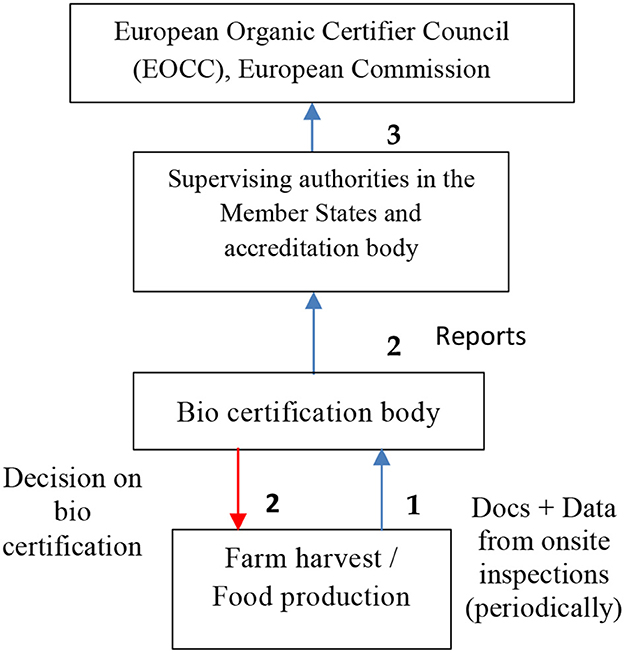
Figure 3. The typically accepted bio certification model in European area. Source: European Court of Auditors (2018) and European Court of Auditors (2019) modified by the authors.
Thus, additional consultations on a possible committee collecting and managing data from bio farmers are required.
Upon analyzing, the highest frequency of repeating combinations coincides with the maximum choice of answers to questions Q1 and Q2 separately, although this may not coincide. This coincidence of options C and Y significantly enhances the overall choice. Figure 4 depicts both the absolute selection of experts and the highest frequency combination of choices for the two questions together.

Figure 4. The certification procedure based on the absolute and combination choices of the experts (SQ1 and SQ2). Source: developed by the authors.
Therefore, there are two key structural differences proposed to the existing bio certification model. First, in the proposed experts' model, the data sources are expanded. For example, data metric indicators were added from points of real food production, which record data from the very 1st day of the production cycle. These data are as objective as possible and serve as a formal reason for a comprehensive analysis of the production point and consequently an objective decision on bio certification. Second, the data flow to the Central European Committee or other central body, where protection law, safety opportunities, and access rights are likely to be more effectively and transparently regulated according to the experts' vision. This will avoid or potentially eliminate a subjective impact from local bio-certification structures, unbalanced local regulations in favor of larger entities, or corruption in the food supply chain. It is also worth noting that almost a quarter, namely 23.3% of experts who chose the “Z” option (Survey 2, Q2), believe that such data should not be centralized at all or somehow controlled by someone. A control itself is always an opportunity to influence objective data, and the blockchain technology as a technology option is able to eliminate this type of risk.
Since the majority of experts have chosen the scheme CY as the better choice (C (Q1), both checks should be made but the priority decision should be made by a licensed bio certification body. An electronic system may take only an assistant function and Y (Q2) data should be collected in a central union database (e.g., EU and OECD) including centralized or centralized but distributed computer systems. Further research and evolution of the current bio certification system should consider exploring this operational strategy.
The characteristics of the newly presented bio certification scheme can manifest as follows:
• Electronic assistants and smart meters are becoming increasingly important and trusted in supporting objective processes, including compliance with organic standards. It is very likely that they will play a key role in evaluating how crops are grown and animals are raised. However, organic certification decisions are still for certifiers but not for digital algorithms.
• Storage and transparency of operational data from production sites will likely move toward central regulators to centralized or distributed computer networks rather than decentralized electronic systems (e.g., blockchain networks), as many experts advocate. This is fully supported by the conclusions of van Hilten et al. (2020) that state that transparency of the food supply system can be ensured by blockchain technology, but for many reasons, including economic feasibility, it does not have to be accompanied by the inclusion of the food supply chain in a fully decentralized system.
• This research supports the study by Havelka et al. (2022) that states that all microclimatic factors in agricultural production sites can now be coordinated electronically with certification bodies. This will lead to more precise regulation of microclimate in the areas of agricultural production.
We also emphasize that this study was conducted in relatively developed countries. Unfortunately, the results of a similar study in developing countries are not known, but obviously food security is at greatest risk in less-developed countries (Smith et al., 2019). Herein, we hypothesize that the likelihood of violations could be more dramatic, considering the results from the first survey on potential violations in organic production. Therefore, the positive effect of integrating the proposed new organic certification structure, formed after an international expert survey, would likely be even more significant. For example, the proposed bio certification model has the chance to partially or completely eliminate fraud in the data collection phase and the corruption phenomena in the organic certification decision phase. This is made possible by a collection, storage, and decision algorithm that has a relatively transparent synchronization between all stages, which is not the case with the classical accepted organic certification model.
5. Conclusion
In conclusion, the main objective of this article was to determine the most likely way for improving the accepted certification system, given that only 3.88% of expert respondents support the current system. It brings evidence from bio farmers themselves with regard to the possibility of violations within organic production under the current system. Further research should focus on understanding how farmers are able to violate the system, what these violations are, and how schemes can work with farmers and other actors to reduce or eliminate these risks. How the presented system is capable of improving requires additional research on the issue. For example, investigating the experimental cycle of the certification process of several agricultural producers to explore improvement options of the current model. These results indicate that the existing process satisfies neither research professionals in the field nor end-users which the certification process aims to serve, as 96.12% of respondents believe that the procedure should change, although we realize that this will remain the subject of possible criticism from some experts. However, essential rethinking is needed for improving the bio certification model if evidence continues to demonstrate issues with the current bio certification system. The European committees are not focused on changing the structural technology itself but concentrated on strengthening the control and quality of awareness and how operators work.
Data availability statement
The raw data supporting the conclusions of this article will be made available by the authors, without undue reservation.
Ethics statement
Ethical review and approval was not required for the study on human participants in accordance with the local legislation and institutional requirements. Written informed consent from the participants was not required to participate in this study in accordance with the national legislation and the institutional requirements.
Author contributions
YK: conceptualization, methodology, resources, and writing—original draft preparation. PK: validation, formal analysis, and data curation. PB: supervision, project administration, and funding acquisition. PS: review and editing.
Funding
The study was supported with ViseGrad Scholar Program under the grant number: 52110235. Additional support (grant number QJ1610324) “The study of traditional and new crops as sources antioxidants and other healthful nutrients and their use in food production” was provided by the Ministry of Agriculture of the Czech Republic.
Conflict of interest
The authors declare that the research was conducted in the absence of any commercial or financial relationships that could be construed as a potential conflict of interest.
Publisher's note
All claims expressed in this article are solely those of the authors and do not necessarily represent those of their affiliated organizations, or those of the publisher, the editors and the reviewers. Any product that may be evaluated in this article, or claim that may be made by its manufacturer, is not guaranteed or endorsed by the publisher.
References
Allen, G. J., and Albala, K. (2007). The Business of Food: Encyclopedia of the Food and Drink Industries. ABC-CLIO, 288.
Bar, T., and Zheng, Y. (2019). Choosing certifiers: Evidence from the British Retail Consortium Food Safety Standard. Am. J. Agric. Econ. 101, 74–88. doi: 10.1093/ajae/aay024
Bravo, C. P., Ramírez, I. V., Neuendorff, J., and Spiller, A. (2013). Assessing the impact of unannounced audits on the effectiveness and reliability of organic certification. Org. Agric 3, 95–109. doi: 10.1007/s13165-013-0048-9
Canada.ca (2016). Open Data, Statistics, Letters and Archives. Available online at: https://inspection.canada.ca/organic-products/equivalence-arrangements/european-union-letters-exchanged/eng/1328075123452/1328075318193 (accessed January 20, 2023).
Canada.ca (2023). Open Data, Statistics, Letters and Archives. Available online at: https://inspection.canada.ca/organic-products/equivalence-arrangements/eucoea-overview/eng/1328074578961/1328074648480#shr-pg0 (accessed January 20, 2023).
Council Regulation (EC) No 834/2007 (2007). Council Regulation (EC) No 834/2007 of 28 June 2007 on Organic Production and Labelling of Organic Products and Repealing Regulation (EEC) No 2092/91, Recital 1. Available online at: https://eur-lex.europa.eu/legal-content/EN/ALL/?uri=CELEX:32007R0834
Drinkwater, L. E. (2009). “Ecological knowledge: Foundation for sustainable organic agriculture,” in Organic Farming: The Ecological System, ed C. Francis. doi: 10.2134/agronmonogr54.c2
EC Report (2022). Report From the Commission on the Overall Operation of Official Controls Carried Out in Member States (2019–2020) to Ensure the Application of Food and Feed Law, Rules on Animal Health and Welfare, Plant Health and Plant Protection Products. Brussels: European Commission, {SWD(2022) 73 final}. Available online at: https://op.europa.eu/en/publication-detail/-/publication/03081a65-d4be-11ec-a95f-01aa75ed71a1 (accessed June 5, 2022).
European Court of Auditors (2018). Organic Food in the EU. Background Paper. Available online at: https://www.eca.europa.eu/Lists/ECADocuments/BP_ORGANIC_FOOD/BP_ORGANIC_FOOD_EN.pdf (accessed June 1, 2022).
European Court of Auditors (2019). Special Report. The Control System for Organic Products has Improved, but Some Challenges Remain. Pursuant to Article 287, Second Subparagraph, TFEU. Available online at: https://www.eca.europa.eu/Lists/ECADocuments/SR19_04/SR_organic-food_EN.pdf (accessed June 1, 2022).
Eurostat (2016). Farm Structure Survey. Available online at: https://ec.europa.eu/eurostat/statistics-explained/index.php?title=Organic_farming_statistics#Fully_organic_farms (assessed May 5, 2023).
Eurostat (2020). Area Under Organic Farming, Eurostat (ORG_CROPAR, ORG_CROPAR_H2), Data Code: SDG_02_40. Available at https://ec.europa.eu/eurostat/databrowser/view/sdg_02_40/default/table?lang=en (assessed Febraury 2, 2023).
Federal Ministry of Food Agriculture in Germany (2020). Organic Farming in Germany, Division 712 – Organic Farming, Bonn. Available online at: https://www.bmel.de/SharedDocs/Downloads/EN/Publications/Organic-Farming-in-Germany.pdf;jsessionid=C973C235F5061B67C2402763868F8C5D.internet2841?__blob=publicationFile&v=4 (accessed June 1, 2022).
Fouilleux, E., and Loconto, A. (2017). Voluntary standards, certification, and accreditation in the global organic agriculture field: a tripartite model of techno-politics. Agri. Hum. Values 34, 1–14. doi: 10.1007/s10460-016-9686-3
Gambelli, D., Solfanelli, F., and Zanoli, R. (2014). Feasibility of risk-based inspections in organic farming: Results from a probabilistic model. Agric Econ. 45, 267–277. doi: 10.1111/agec.12063
Gantz, S. D. (2014). Chapter 5 - Types of Audits, The Basics of IT Audit, Pages 83-104, ISBN 9780124171596. Available online at: https://www.sciencedirect.com/science/article/pii/B9780124171596000055 (accessed June 1, 2022).
Glavan, M., Bele, S., Curk, M., and Pintar, M. (2020). Modelling impacts of a municipal spatial plan of land-use changes on surface water quality—Example from Goriška Brda in Slovenia. Water. 12, 189. doi: 10.3390/w12010189
Havelka, Z., Kunes, R., Kononets, Y., Stokes, J. E., Smutny, L., Olsan, P., et al. (2022). Technology of microclimate regulation in organic and energy-sustainable livestock production. Agriculture 12, 1563. doi: 10.3390/agriculture12101563
ISCC (2021). ISCC EU 201 System Basics. ISCC System GmBH. Available online at: https://www.iscc-system.org/wp-content/uploads/2022/05/ISCC_EU_201_System_Basics-v4.0.pdf (assessed May 5, 2023).
Karalliyadda, S. M. C. B., and Kazunari, T. (2020). Compliance of small-scale organic tea farmers with organic standards: A study in Sri Lanka. J. Agri. Sci. 15, 1–18. doi: 10.4038/jas.v15i1.8668
Kononets, Y., and Treiblmaier, H. (2020). The potential of bio certification to strengthen the market position of food producers. Modern Supply Chain Res. Appl. Emerald Publ. 3, 41–55. doi: 10.1108/MSCRA-05-2020-0013
Kononets, Y., Treiblmaier, H., and Rajčániová, M. (2022). Applying blockchain-based smart contracts to eliminate unfair trading practices in the food supply chain. Int. J. Logist. Syst. Manag. 43, 127082. doi: 10.1504/IJLSM.2022.127082
Miśniakiewicz, M., Łuczak, J., and Maruszewska, N. (2021). Improvement of organic farm assessment procedures on the example of organic farming in Poland—Recommendations for organic farming in Poland. Agronomy 11, 1560. doi: 10.3390/agronomy11081560
Nowicki, P., Cwiklicki, M., Kafel, P., and Wojnarowska, M. (2021). Credibility of certified environmental management systems: Results from focus group interviews. Environ. Impact Assess. Rev. 88, 106566. doi: 10.1016/j.eiar.2021.106556
Organic Farming Information System Agricultural (2022). Control Bodies and Authorities from Member States. Agriculture and Rural Development (DG Agri), EC. Available online at: https://ec.europa.eu/agriculture/ofis_public/actor_cbeu/ctrl.cfm?targetUrl=home (assessed June 4, 2022).
Padel, S., Vine, J., Huber, B., Stolze, M., Jespersen, L. M., Rüegg, E., et al (2010). The European Regulatory Framework and Its Implementation in Influencing Organic Inspection and Certification Systems in the EU. Available online at: http://orgprints.org/18359/1/padel-etal-2010-certcost.pdf (assessed May 5, 2023).
Paull, J. (2011). Attending the first organic agriculture course: Rudolf Steiner's agriculture course at Koberwitz, 1924. Eur. J. Soc. Sci. 21, 64–70.
Regulation (EU) 2018/848 (2018). 2018/848 of the European Parliament and of the Council on organic production and labelling of organic products and repealing Council Regulation (EC) No. 834/2007. Off. J. Eur. Union L 150, 1–92.
Research Institute of Organic Agriculture (2021). Area Data on Organic Agriculture in the EU 2000-2020. The Statistics.FiBL.org website maintained by the Research Institute of Organic Agriculture (FiBL), Frick, Switzerland. Available online at: https://statistics.fibl.org/europe/key-indicators-europe.html (accessed June 4, 2022).
Safe Food for Canadians Regulations (2022). The Minister of Justice in Canada, Consolidation SOR/2018-108. Available online at: https://laws-lois.justice.gc.ca/PDF/SOR-2018-108.pdf (accessed January 21, 2023).
Smith, O. M., Cohen, A. L., Rieser, C. J., Davis, A. G., Taylor, J. M., Adesanya, A. W., et al. (2019). Organic farming provides reliable environmental benefits but increases variability in crop yields: A global meta-analysis. Front. Sustain. Food Syst. 3, 82. doi: 10.3389/fsufs.2019.00082
Staudenmaier, P. (2008). Race and redemption: Racial and ethnic evolution in Rudolf Steiner's anthroposophy. Nova Religio 11, 4–36. doi: 10.1525/nr.2008.11.3.4
Thompson, T., Freestone, D., Michalczyk, A. A., and Leigh Ackland, M. (2012). Copper levels in buccal cells of vineyard workers engaged in various activities. Ann. Occup. Hyg. 56, 305–314. doi: 10.1093/annhyg/mer086
van Hilten, M., Ongena, G., and Ravesteijn, P. (2020). Blockchain for organic food traceability: Case studies on drivers and challenges. Front. Blockchain 3, 567175. doi: 10.3389/fbloc.2020.567175
Vogt, G. (2007). “Chapter 2: The origins of organic Farming,” in Organic Farming An International History, ed W. Lockeretz. (New York, NY: CABI Publishing), 9–30.
Von Friedeburg, A. (2018). Got ‘BIO?'—Organic Food Made in Germany. Available online at: https://germanfoods.org/german-food-facts/german-organic-foods/ (accessed October 25, 2020).
Zezza, A., Demaria, F., Laureti, T., and Secondi, L. (2020). Supervising third-party control bodies for certification: the case of organic farming in Italy. Agric. Econ. 8, 26. doi: 10.1186/s40100-020-00171-3
Zorn, A., Lippert, C., and Dabbert, S. (2012). Supervising a system of approved private control bodies for certification: the case of organic farming in Germany. Food Control 25, 525–532. doi: 10.1016/j.foodcont.2011.11.013
Keywords: food certification, bio certification, organic food, organic certification, organic farming, organic agriculture, food supply chain, certification body
Citation: Kononets Y, Konvalina P, Bartos P and Smetana P (2023) The evolution of organic food certification. Front. Sustain. Food Syst. 7:1167017. doi: 10.3389/fsufs.2023.1167017
Received: 15 February 2023; Accepted: 20 April 2023;
Published: 01 June 2023.
Edited by:
Vinod Kumar Singh, Indian Council of Agricultural Research, IndiaReviewed by:
Gopinath K. A., Central Research Institute for Dryland Agriculture (ICAR), IndiaDan Donosa, Iasi University Life Sciences (IULS), Romania
Copyright © 2023 Kononets, Konvalina, Bartos and Smetana. This is an open-access article distributed under the terms of the Creative Commons Attribution License (CC BY). The use, distribution or reproduction in other forums is permitted, provided the original author(s) and the copyright owner(s) are credited and that the original publication in this journal is cited, in accordance with accepted academic practice. No use, distribution or reproduction is permitted which does not comply with these terms.
*Correspondence: Yevhen Kononets, eWV2aGVuLmtvbm9uZXRzQHVrci5uZXQ=
 Yevhen Kononets
Yevhen Kononets Petr Konvalina2
Petr Konvalina2